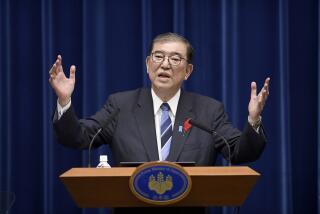Hashimoto to Lead Top Japan Party : Politics: Trade minister now most likely to become premier. Liberal Democrats hope he will add pizazz to party’s sagging image.
- Share via
TOKYO — Ryutaro Hashimoto, Japan’s steely and sharp-tongued trade minister who faced down the United States in recent auto negotiations, was overwhelmingly elected president of the leading Liberal Democratic Party on Friday.
Hashimoto, 58, was elected on hopes that he will revive the sagging popularity of the once-invincible party with his articulate views, keen grasp of policy issues, vast political experience and good looks.
Widely disliked for his arrogance, however, Hashimoto failed in two previous attempts for the party’s top spot. He got the nod this time, trouncing former Posts and Telecommunications Minister Junichiro Koizumi, largely because party elders were stunned at the unexpected strength shown by the opposition New Frontier Party in July’s upper-house parliamentary elections.
In a news conference, Hashimoto said he would work to put together a “fresh, stable, active and powerful” team that would win back the trust of the people--more than 50% of whom now say they support no political party.
Liberal Democratic leaders believed that Hashimoto was the best candidate to add pizazz to the party’s limp image and its best chance to avoid defeat in still-unscheduled general elections, analysts said.
“I think he’ll be good for the LDP because he speaks out clearly,” said Yoshimichi Hironaka, deputy political editor of the Yomiuri Shimbun, the nation’s largest newspaper.
Hashimoto’s election propels him into the leading position to become prime minister--a job that would be assured except that the Liberal Democrats lost their monopoly lock on power in 1993. Now the party shares power with the Socialists and the New Party Harbinger, and it remains uncertain if and when Hashimoto would take over from Tomiichi Murayama, the current Socialist premier.
*
Murayama has vowed to stay in office until the 1996 national budget is completed in the spring.
A recent poll by the Asahi Shimbun newspaper, however, showed Hashimoto to be the public’s runaway favorite for prime minister, supported by 21% compared to 4% for the nearest contenders against Murayama, outgoing Liberal Democratic President Yohei Kono and New Frontier Party leader Toshiki Kaifu.
Despite a fresh image as a direct, decisive man who stands out in the murky world of Japanese politics, Hashimoto is not likely to push deregulation or crusade for other reforms. He traces his political lineage to the machine politics of the late Liberal Democratic kingmaker Kakuei Tanaka, and he personifies the party’s conservative traditions.
Although he declared that his top priority will be to revive the stubbornly ailing economy, Hashimoto has prescribed traditional measures, such as tax cuts and deficit financing for more public-spending packages.
*
And despite his notorious reputation for publicly dressing down bureaucrats, Hashimoto has generally followed their policy advice--including appeals to take a strong stand against U.S. requests for numerical measures of progress in opening the auto market.
Hashimoto is often identified as a hawk who supports reviewing the peacetime constitution to allow a more assertive role for the nation’s Self-Defense Forces in global peacekeeping operations. He also advocates a permanent seat for Japan on the United Nations Security Council.
He heads the Japan War Bereaved Families Assn., which has long objected to war apologies. But Hashimoto himself acknowledges that Japan committed wartime acts of aggression and says the nation should apologize to Asia--though not to the West.
Some critics said his succession to the Liberal Democrats’ top post could weaken relations with his more liberal coalition partners. But Hashimoto has vowed to maintain the three-party alliance.
More to Read
Sign up for Essential California
The most important California stories and recommendations in your inbox every morning.
You may occasionally receive promotional content from the Los Angeles Times.














